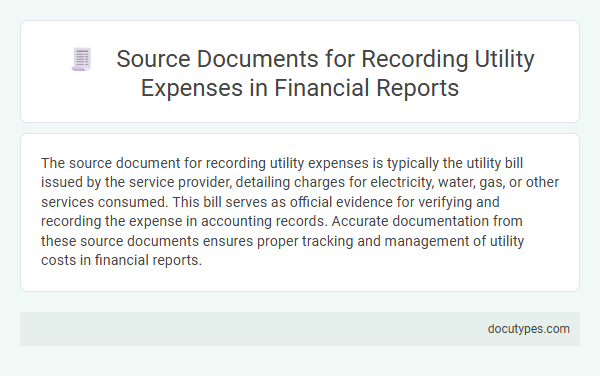The source document for recording utility expenses is typically the utility bill issued by the service provider, detailing charges for electricity, water, gas, or other services consumed. This bill serves as official evidence for verifying and recording the expense in accounting records. Accurate documentation from these source documents ensures proper tracking and management of utility costs in financial reports.
Introduction to Source Documents in Utility Expense Reporting
| Topic | Details |
|---|---|
| Introduction to Source Documents | Source documents serve as the original records that provide evidence and details for financial transactions. In the context of utility expense reporting, these documents are essential for accurate and verifiable accounting. They enable organizations to track spending, validate costs, and maintain compliance with financial regulations. |
| Purpose of Source Documents | Source documents form the foundation for recording utility expenses systematically. They support the integrity of accounting records and facilitate audits by providing proof of utility consumption and payments. |
| Examples of Source Documents | Common source documents for utility expenses include utility bills, invoices from service providers, payment receipts, and contracts outlining service agreements. Each document contains critical data such as billing periods, consumption details, rates, and total amounts due. |
| Your Role in Handling Source Documents | You are responsible for accurately collecting, organizing, and maintaining source documents to ensure utility expenses are recorded correctly in accounting systems. Proper handling of these documents aids in financial transparency and efficient expense management. |
Importance of Accurate Documentation for Utility Expenses
The source document for recording utility expenses is typically the utility bill received from service providers. Accurate documentation of these expenses is essential for precise financial reporting and budgeting.
- Utility Bills - These provide detailed information on the amount owed, billing period, and service usage, serving as primary evidence for recording expenses.
- Payment Receipts - Receipts confirm the payment of utility bills and help reconcile accounts payable with actual cash outflows.
- Meter Readings - Regular meter readings support the verification of utility bills, ensuring accuracy in reported expenses.
Types of Utility Expenses in Financial Reporting
The source document for recording utility expenses is typically the utility bill issued by service providers such as electricity, water, gas, and internet companies. These bills contain detailed information, including the billing period, amount due, and account details, which are essential for accurate financial reporting.
Types of utility expenses recorded in financial reports include electricity charges, water and sewage fees, natural gas costs, and telecommunications expenses. Proper classification of these utility expenses ensures transparency and compliance with accounting standards in financial statements.
Common Source Documents for Utility Expense Recording
Utility expenses are recorded based on specific source documents that provide accurate details of usage and payment. These documents serve as the primary evidence for accounting entries related to utility costs.
- Utility Bills - Detailed invoices from service providers showing consumption, rates, and total amounts due.
- Payment Receipts - Proof of payment confirming the settlement of utility charges in the accounting records.
- Meter Reading Reports - Records capturing actual utility consumption data used to verify billing accuracy.
Utility Bills: Key Components and Verification
The primary source document for recording utility expenses is the utility bill issued by service providers. These bills contain essential information that ensures accurate accounting and verification of utility costs.
- Account Information - Utility bills include the customer account number and service address for identification purposes.
- Billing Period and Usage - The statement specifies the billing cycle dates along with the meter readings and total consumption.
- Charges and Payment Details - Itemized charges, taxes, fees, and the total amount due provide clear documentation of expenses incurred.
Verification of utility bills involves cross-checking meter readings and ensuring the charges align with contracted rates to maintain accuracy in financial records.
Receipts and Payment Vouchers for Utility Transactions
The source document for recording utility expenses primarily includes receipts and payment vouchers related to utility transactions. Receipts provide proof of payment for services such as electricity, water, and gas, detailing the amount paid and the date of the transaction. Payment vouchers serve as internal authorization for the disbursement of funds toward utility bills, ensuring accurate recording and accountability in financial statements.
Electronic Statements and Online Payment Confirmations
The source document for recording utility expenses primarily includes electronic statements issued by service providers. These statements provide detailed information on consumption, billing periods, and total amounts due, essential for accurate financial records. Your online payment confirmations also serve as proof of transaction, validating the utility expenses recorded in accounting systems.
Internal Approval Memos for Utility Expense Authorization
Internal approval memos serve as the primary source document for recording utility expenses. These memos provide formal authorization for utility payments, ensuring compliance with company policies.
They typically include details such as the expense amount, utility provider, billing period, and approval signatures. Using internal approval memos helps maintain an accurate and auditable record of utility expenses within the accounting system.
Record Retention Policies for Utility Expense Documents
The source document for recording utility expenses is typically the utility bill or invoice received from the service provider. These documents detail the amount owed, service period, and payment terms necessary for accurate expense tracking.
Utility expense documents must be retained according to your organization's record retention policies, often ranging from three to seven years. Proper storage ensures compliance with tax regulations and facilitates auditing processes. Digital copies are increasingly accepted, but they must be clear and accessible for reference.
What Is the Source Document for Recording Utility Expenses? Infographic

